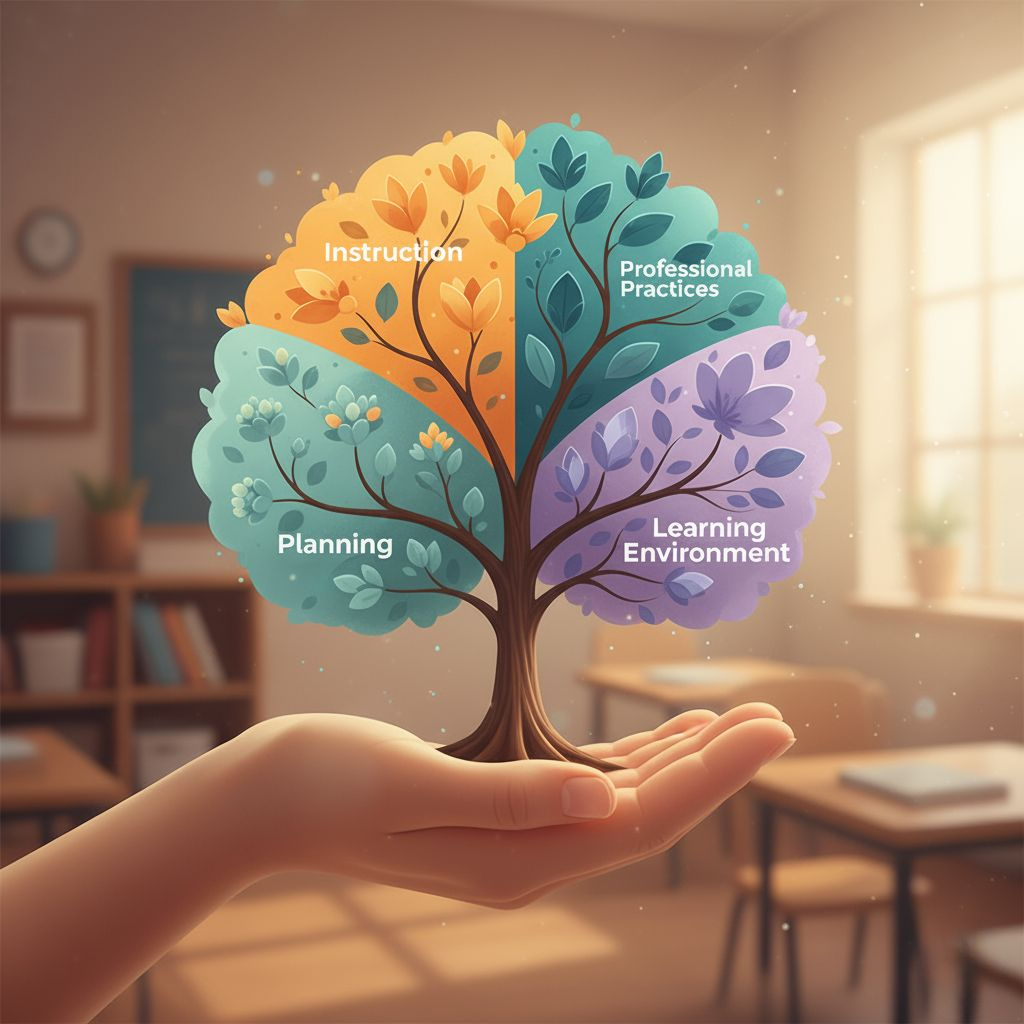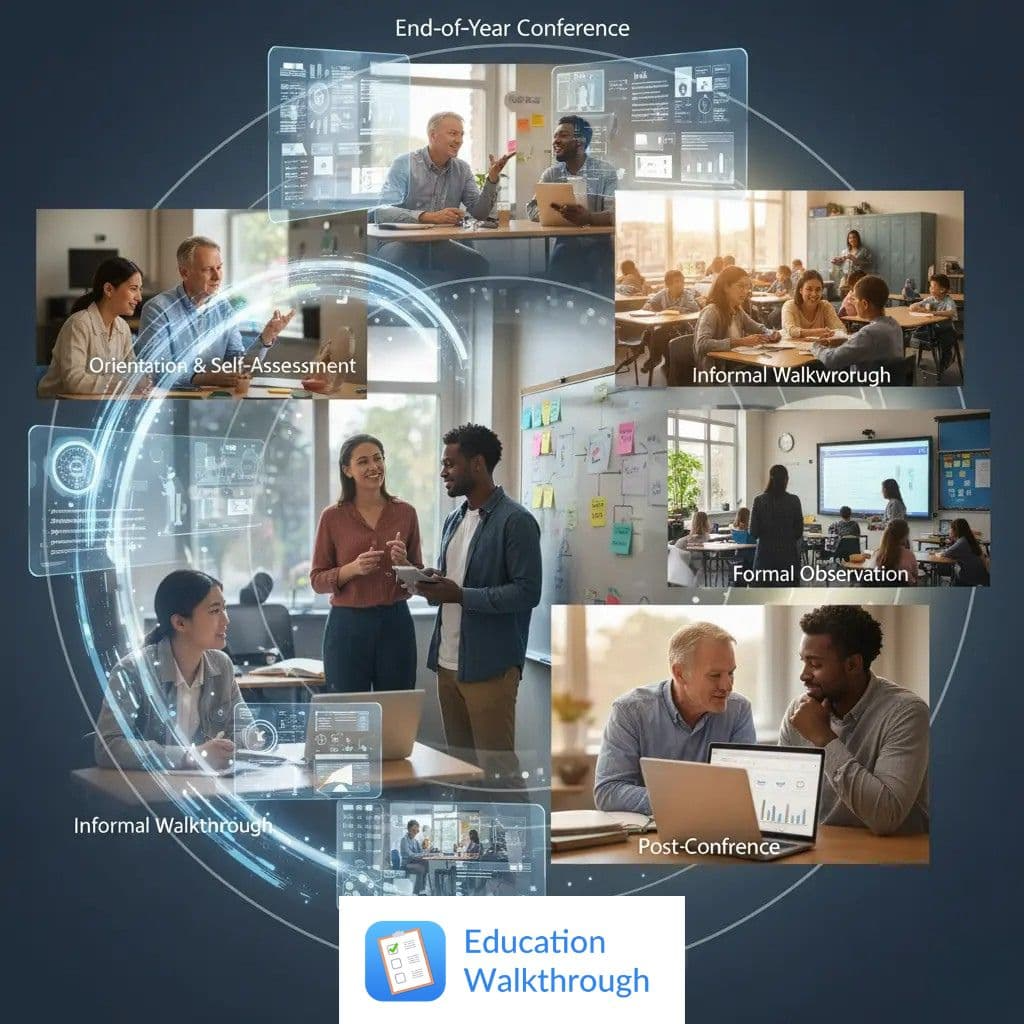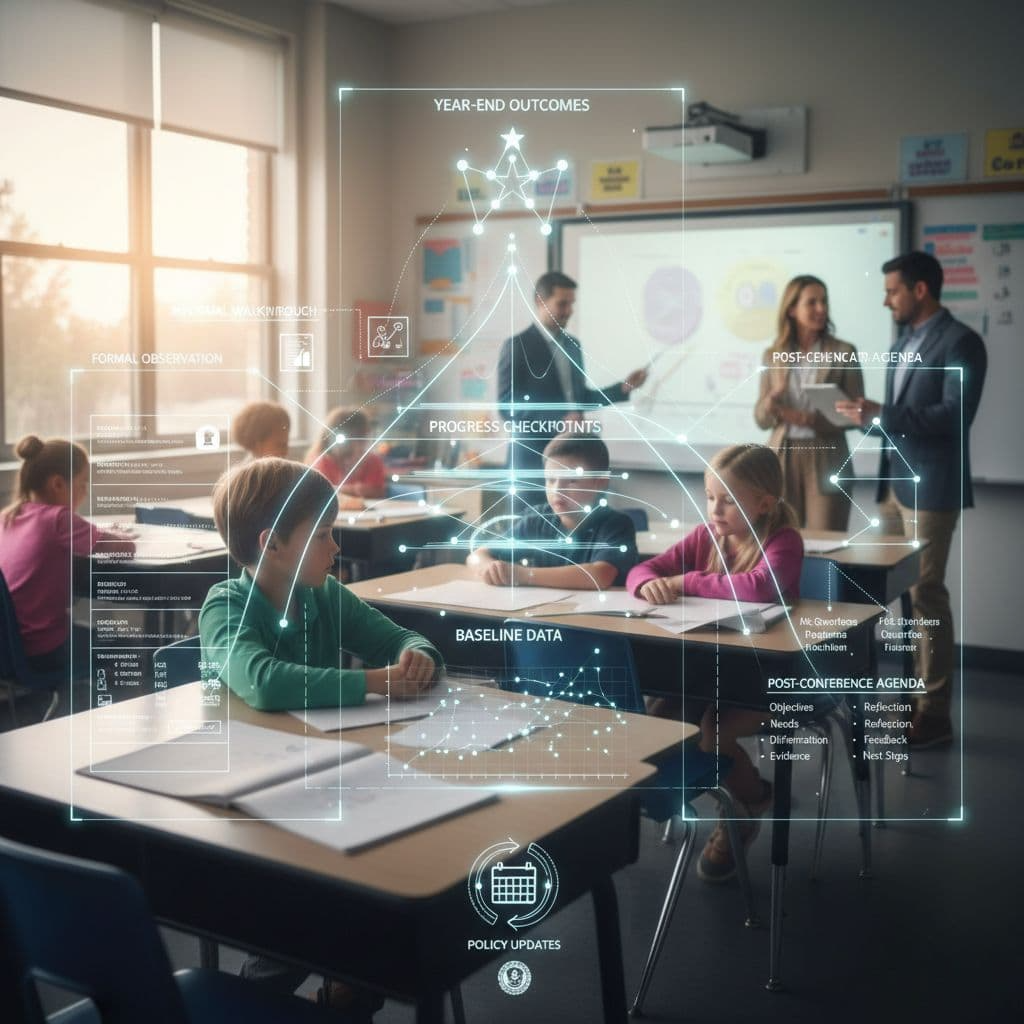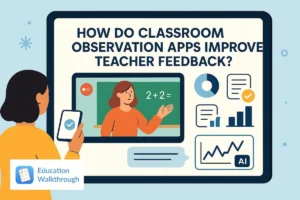For many Texas educators, the T-TESS evaluation cycle can feel like just another hoop to jump through. But when you look a little closer, it’s designed to be so much more than a compliance checklist.
At its core, T-TESS is about helping teachers grow through goal-setting, meaningful feedback, and regular conversations that support. Rather than focusing on a single observation, the T-TESS cycle is designed to support educators throughout the school year.
It centers on four key teaching domains and encourages continuous reflection and improvement. Once educators understand its rhythm, the cycle shifts from something intimidating into a framework that genuinely helps teachers refine their practice and impact their students.
What Is the T-TESS Evaluation Cycle?

The T-TESS evaluation cycle is Texas’s official teacher appraisal system, designed to prioritize professional growth over compliance. Instead of a single “gotcha” moment, it unfolds across the year with goal-setting, rubric-aligned observations, and coaching conversations.
The real goal? Elevating instructional practice while keeping student learning front and center.
At Education Walkthrough, we’ve seen countless teachers initially approach T-TESS with dread. However, they then realize that, when done right, it’s a coaching partnership.
The cycle emphasizes ongoing, evidence-based dialogue through pre- and post-conferences, frequent walkthroughs, and clear feedback. Instead of being left wondering how educators performed after one visit, they’ll have multiple touchpoints to talk through their practice and make adjustments in real time.
Understanding the Core Components of T-TESS

To make the most of the T-TESS evaluation cycle, it’s helpful to break it down into its core components.
The Four Rubric Domains and Scoring
The heart of T-TESS lies in its four domains, each describing a vital area of teaching practice. Evidence collected during observations maps back to these domains and dimensions, helping the evaluator give consistent, specific feedback.
Each domain is scored across five levels:
- Improvement Needed
- Developing
- Proficient
- Accomplished
- and Distinguished.
Most educators land in the middle ranges, and that’s okay. The system is designed for steady growth, not perfection.
Domain 1: Planning
How the educator thoughtfully prepares lessons and aligns instruction to standards. Also, it looks at how they differentiate diverse student needs, anticipate challenges, and design activities that promote engagement and mastery before stepping into the classroom.
Domain 2: Instruction
This domain focuses on the teaching process during class, including the classroom management strategies used and how educators engage students. Teachers should adapt lessons on the fly, ask purposeful questions, and provide feedback that supports learning and critical thinking.
Domain 3: Learning Environment
The classroom culture that educators create encompasses routines, behavior expectations, and positive relationships. This environment helps students feel safe, respected, and motivated to learn.
Domain 4: Professional Practices and Responsibilities
The teacher’s professionalism includes communication, collaboration with colleagues, and engagement in professional development. They should also reflect on their practice and make ongoing efforts to grow as an educator, supporting student success.
| Domain | Focus Area |
| 1. Planning | Lesson preparation and student needs |
| 2. Instruction | Delivery, engagement, responsiveness |
| 3. Learning Environment | Classroom management and relationships |
| 4. Professional Practices | Communication, collaboration, growth |
Student Growth Measures
Teaching effectiveness centers on student outcomes. Districts use different growth measures to capture how students progress.
These include:
- Student Learning Objectives (SLOs)
- State standardized test scores
- Local district assessments
- Classroom-based pre- and post-assessments
The Texas Education Agency outlines a matrix approach that combines rubric performance with student growth data. At the end of the year, both pieces come together to form a holistic picture of the educator’s impact.
| Growth Measure | Description |
| SLOs | Teacher-created goals for tracking student learning |
| State Assessments | STAAR or other state tests |
| District Assessments | Local benchmarks and exams |
| Classroom Assessments | Pre/post-tests, unit assessments |
Goal-Setting and Professional Development (GSPD)
At the start of each year, teachers will complete a self-assessment and set 1–2 SMART goals (Specific, Measurable, Achievable, Relevant, and Time-bound). These SMART goals for educators serve as a roadmap for professional growth, directly tied to teaching and students’ needs.
Teachers will also meet with their evaluator in a goal-setting conference to finalize these goals, check progress throughout the year, and make adjustments as needed.
Mandatory Documentation and Artifacts
Part of the compliance side of T-TESS is maintaining organized records. These include:
- Self-assessment
- GSPD form
- Lesson plans
- Observation evidence
- End-of-year documentation
Staying on top of this throughout the year means educators won’t be scrambling at the end.
Many evaluators and educators create digital folders or platforms to keep artifacts organized. Our promise at Education Walkthrough is to help educators simplify the feedback walkthrough process. This is because when less time is spent hunting down paperwork and getting organized, there will be more free time for professional growth and development.
A Teacher’s Guide to the T-TESS Cycle at a Glance

Each stage of the T-TESS evaluation cycle builds on the last, giving teachers multiple chances to reflect, set goals, and demonstrate growth. When they see it as a flow rather than a one‑time event, the process feels far less intimidating and much more purposeful.
Orientation & Self-Assessment
At the very beginning of the year, districts hold orientation sessions to walk teachers through the T-TESS process, expectations, and timelines.
Right after, they’ll complete a rubric-based self-assessment to reflect on their strengths and areas for growth. This step isn’t about “grading themselves”; it’s about setting the foundation for meaningful professional development.
Goal-Setting Conference
Next comes the goal-setting conference, where the educator and the evaluator sit down to align on SMART goals (Specific, Measurable, Achievable, Relevant, and Time-bound). These goals guide your professional development activities and provide a focus for ongoing support.
Pre-Conference
Before the formal observation, you’ll have a pre-conference with your evaluator. This meeting sets the stage. Share the context of the upcoming lesson, explain student needs, and discuss the evidence that should be collected.
It’s a great chance to provide insight into the “why” behind the teacher’s planning, not just the “what.” By clarifying expectations up front, there will be no guesswork; instead, it creates a more supportive teacher observation experience.
Formal Observation
During the formal teacher observation, a certified evaluator observes an entire lesson and records objective evidence tied to the T-TESS rubric. This stage creates a clear snapshot of the teaching practice. Evaluators are trained to focus on what they see and hear, not personal opinion. Therefore, the feedback connects directly to rubric dimensions.
Post-Conference
Within a short window after your observation, teachers and evaluators will meet for a post-conference. Here, teachers will reflect on their lesson, and the evaluator will connect their evidence to the rubric while co-creating next steps.
This is one of the most valuable conversations in the cycle because it’s where evidence turns into growth strategies.
Informal Walkthroughs
Throughout the year, your evaluator may conduct several informal walkthroughs. These are short, unannounced visits meant to provide real-time, just‑in‑time feedback.
They help keep the momentum of your goals alive between formal checkpoints. Walkthroughs are also touchpoints to support you and track progress. Our classroom walkthrough software enables educators to observe, document and analyze consistent patterns over time, rather than relying on a single isolated observation.
End-of-Year Conference
Finally, the cycle concludes with the end-of-year conference.
This is where all evidence is synthesized: Domains 1–3 are reviewed, Domain 4 is formalized with teacher-provided artifacts, and student growth measures are considered.
Together, the teacher and evaluator reflect on the year, celebrate progress, and begin planting the seeds for next year’s goals.
Roles and Responsibilities in the T-TESS Cycle

The T-TESS evaluation cycle works best when everyone involved knows their role and follows through with consistency. Teachers, appraisers, and district leaders each play a part in making the system a culture of continuous growth.
Here’s what each role looks like in practice.
Teacher Responsibilities
As a teacher, your biggest responsibility is engaging fully in the process, not just checking off boxes. That starts with your self-assessment at the beginning of the year, where you take an honest look at your practice and identify areas for growth. From there, you’ll set meaningful goals, track your progress, and make sure your daily classroom work reflects the growth areas you’ve prioritized.
After each post-conference, it’s vital to put feedback into action. Keep notes on what worked, what didn’t, and what you might tweak. This way, by the end-of-year conference, you’ve got real evidence of progress.
You’ll also need to curate evidence of your professional practices throughout the year. This can include records of parent communication, collaboration with colleagues, and documentation of professional learning. Organized evidence not only makes your final evaluation smoother, but it also shows the bigger picture of how you contribute to your campus.
Appraiser Obligations
Evaluators, or appraisers, carry the responsibility of ensuring the process is fair, consistent, and growth-focused. They’re trained to use the rubric with fidelity and should maintain calibration across teachers so everyone is evaluated on the same standards.
During observations and teacher evaluations, appraisers must collect objective evidence, capture exactly what they see and hear, rather than relying on subjective impressions.
A strong appraiser helps identify strategies, resources, and professional development opportunities that support your goals.
Leadership and District Oversight
District leaders play the role of architects in the T-TESS system. They establish calendars, policies, and training that set the tone for how the process unfolds in each school.
Clear communication is key here. Teachers and evaluators need to know deadlines for conferences, observation windows, and how student growth measures will be applied.
Leadership also ensures appraisers are trained, calibrated, and supported in their work. This matters for fairness across the district, so one school isn’t using a different standard than another. By monitoring fidelity and inter-rater reliability, districts keep the process transparent and consistent.
How T-TESS Can Be Customized and Extended
The T-TESS evaluation cycle is flexible enough to meet the unique needs of every educator and every campus. Districts can adjust expectations, supports, and even documentation requirements so the system works for both new and experienced teachers.
When customization is done thoughtfully, T-TESS becomes a tool for growth rather than a one-size-fits-all checklist.
New vs. Experienced Educators
New teachers often need a stronger support system to help them navigate classroom realities and T-TESS expectations. This can mean more frequent observations, targeted instructional coaching communication, and specialized professional development.
Veteran educators, on the other hand, may focus on advanced instructional strategies or leadership roles within the T-TESS framework. The basic rubric works for everyone, but districts can differentiate support based on experience and individual needs.
Documentation Validation and Audit Trails
Keeping organized records is key for Domain 4 and student growth measures. Whether you use digital portfolios, apps, or physical folders, consistent artifact management streamlines reviews and simplifies end-of-year conferences. Districts should also provide clear procedures for extensions or unusual circumstances, so you know what to do if timelines shift.
Career Impact of Ratings
Summative evaluations influence your long-term professional trajectory.
High ratings can open doors to leadership roles, special projects, or recognition opportunities, while lower ratings typically signal areas for targeted support.
Regardless of current standing, ratings are best used as a motivation for ongoing improvement, reflecting the principle that growth is the ultimate goal.
SEL and Culturally Responsive Practice
T-TESS provides multiple opportunities to integrate social-emotional learning (SEL) and culturally responsive teaching into your practice. Teachers can set goals related to building positive relationships, fostering inclusive environments, and documenting these practices.
Mentor and Peer Coaching Models
Many districts enhance T-TESS with mentoring programs, peer observation protocols, and reflective practice circles. Pairing new or refining teachers with experienced colleagues provides additional feedback, growth opportunities, and collaborative learning beyond formal evaluations.
These supports help cultivate a culture of continuous improvement campuswide, ensuring professional growth is ongoing and embedded in daily practice.
What Specific Technical Details Matter Most?

Understanding the technical details of T-TESS helps you navigate the system with confidence and ensures your evidence and feedback align with expectations. These details clarify how data is collected, how observations work, and how conferences should be structured.
Data Collection for Student Growth
Student growth measurement should be meaningful, fair, and aligned to what you actually teach. Establish clear baselines at the start of the year, track progress through regular checkpoints, and analyze outcomes at year-end to inform the next cycle’s goals.
For subjects with state-mandated tests, growth is often measured through those scores. In other cases, districts may rely on local assessments, classroom-based measures, or collaboratively developed Student Learning Objectives (SLOs).
Differences Between Formal and Informal Observations
Formal observations are comprehensive, evidence-rich events across Domains 1–3, whereas informal walkthroughs are brief, frequent visits that provide coaching insights and may influence ratings per local policy.
Formal observations usually cover an entire lesson, include pre- and post-conferences, and result in rubric ratings. Most teachers experience 1–2 formal observations each year.
Informal walkthroughs are shorter (10–15 minutes), providing snapshots of day-to-day teaching practices without necessarily generating a formal rating. Recognizing these differences helps teachers prepare appropriately for each type of visit.
Recommended Conference Agendas and Questions
Clear conference agendas make discussions more productive.
Pre-conference: Discuss lesson objectives, student needs, differentiation strategies, and focal evidence. This provides context for what the evaluator will see.
Post-conference: Begin with your reflection on the lesson, then receive evidence-based feedback from the evaluator, and collaborate on next steps and professional development resources. Structured conversations ensure feedback is actionable and aligned to rubric dimensions.
Timeline Variations and Policy Updates
Districts set local calendars for observation windows and conferences, and procedures may change based on TEA guidance or local policy updates. Some districts spread observations throughout the year, while others concentrate them in specific months. Conference timelines also vary, so staying informed about policy and procedural changes is essential for compliance and planning.
What Do Educators Ask Most Often?
Here are a few questions we hear from educators.
How does T-TESS differ from legacy checklists?
It’s growth-centered, rubric-driven, and anchored in recurring feedback across a full cycle rather than single events. It focuses on improving teaching over time rather than checking boxes once.
How often should informal walkthroughs occur?
TEA recommends multiple informal observations across the year, with specifics defined by district policy. Frequency varies by district, but the goal is consistent feedback.
Can additional feedback or observations be requested?
Many districts allow extra observations or coaching conversations aligned to your GSPD. Evaluators often welcome proactive requests for feedback.
What if deadlines are missed?
Follow district procedures for extensions and document communications to maintain compliance. Inform your evaluator promptly if scheduling conflicts or emergencies affect deadlines.
Where To Go for Deeper Resources?
Navigating the T-TESS evaluation cycle can feel complex, but there are excellent resources to help you understand the framework, plan effectively, and track growth. These materials provide practical guidance, templates, and examples to make each stage of T-TESS more manageable and meaningful.
- Rubrics & domains explained: The official T-TESS Rubric provides a deep dive into dimensions and performance levels for calibration and planning.
- Creating effective T-TESS goals: The T-TESS Implementation Guidebook includes SMART exemplars, alignment checklists, and progress-tracking templates.
- Observation preparation checklist and post-conference guide: Visit TeachForTexas Evaluation Process for agendas, prompts, and evidence-mapping tips.
- Student growth measures 101 and template library: The Texas Teacher Evaluation and Support System page provides SLO setup, baseline-to-EOY trackers, and artifact organizers.
- Additional support resources: ESC Region 15 offers training materials and implementation support for administrators and teachers.



